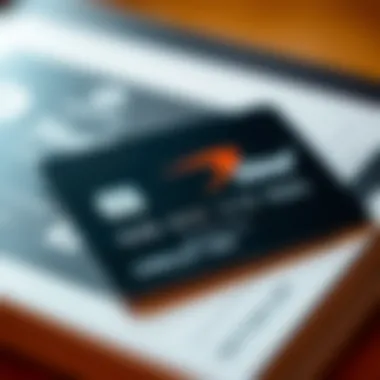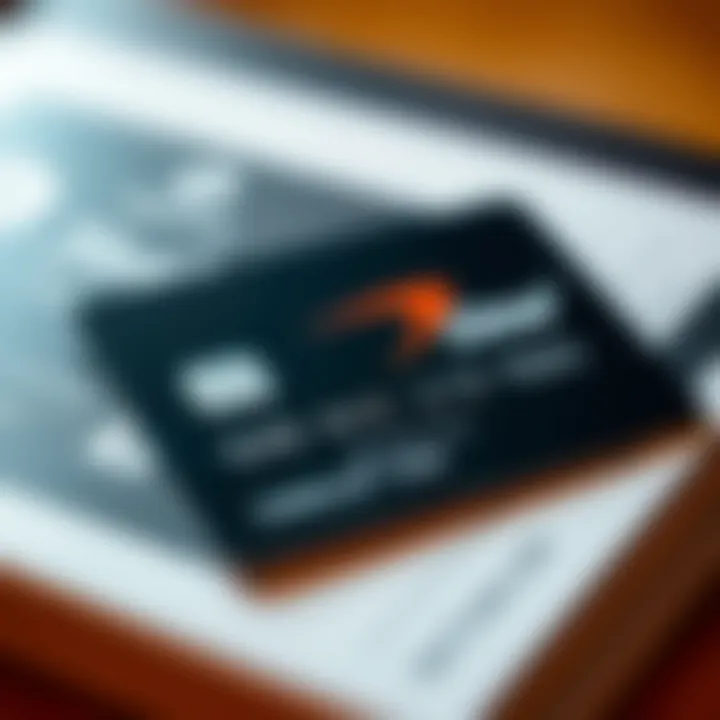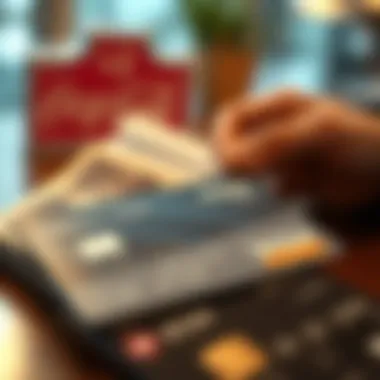Mastering Your Payments with the Credit One Card


Intro
In today’s fast-paced world, managing finances effectively is more critical than ever. Among various tools available, the Credit One card stands out as a beneficial resource for numerous individuals, from young professionals to small business owners. This guide aims to discuss how to navigate payment processes associated with the Credit One card, providing clarity on payment methods, fees, and fostering overall financial literacy. Understanding these components can empower users to make smarter financial choices.
Understanding Financial Concepts
Definitions of Key Terms
Navigating the world of credit cards requires a grasp of a few essential terms. The most basic one is a credit limit, which is the maximum amount you can borrow on your card. It's crucial to stay within this limit to avoid penalties. Additionally, APR (Annual Percentage Rate) is what you essentially pay in interest on any outstanding balance. Then there's minimum payment, the least amount you are required to pay each month to keep your account in good standing. Lastly, understanding what constitutes a late fee is vital; it's the penalty charged when payment isn't made by the due date.
These terms are not just jargon; they are the cornerstones of responsible credit usage.
Importance of Financial Literacy
Grasping these concepts is just the tip of the iceberg. Financial literacy—your ability to make informed judgments about your finances—is vital for anyone seeking to hold a Credit One card. With good financial knowledge, managing payments, understanding fees, and avoiding pitfalls become second nature.
Financial literacy can lead to significant long-term benefits. According to reports from sources like National Endowment for Financial Education, well-informed individuals are less likely to accumulate debt and more likely to save for emergencies. Further, they can make wise investment decisions, paving the way for a secure financial future.
Creating a Personal Budget
Creating a personal budget is a fundamental step toward financial health. It helps you visualize your income and outlay, ensuring that you live within your means.
Setting Financial Goals
Setting clear and measurable financial goals is an important aspect of budgeting. Whether it’s saving for a vacation, paying off debt, or simply building an emergency fund, writing down your goals can give you a clear focus. For example, if you aim to pay off a credit card, specify an amount like "$200 a month" instead of just saying "I want to pay it off."
Tracking Income and Expenses
Regularly tracking your income and expenses can be like mapping out a journey; you need to know where you are coming from to see where you are going. Various apps can simplify this process. Regular reviews allow you to spot unnecessary expenditures. For instance, if you notice that coffee runs every morning add up to nearly $100 monthly, you may consider cutting back.
Effective budgeting empowers you to make informed decisions about how and when to use your Credit One card, ultimately helping to manage payments more efficiently.
Ending
Understanding payment processes with a Credit One card is not merely about knowing how to make payments; it’s about building a framework of financial literacy that will serve you in the long run. By exploring financial concepts and establishing a personal budget, you not only manage your card wisely but also pave the way for a future filled with smart financial decisions.
Intro to Credit One Card Payments
When acquiring a credit card, particularly the Credit One card, it’s crucial to grasp the nuances of its payment processes. Managing payments efficiently can set the tone for your financial health. This section introduces the various aspects of how the Credit One card payments function, emphasizing the significance of understanding these processes for a seamless experience.
Understanding Your Credit One Card
First and foremost, knowing what the Credit One card offers can pave the way for smart financial decisions. The card is designed for individuals looking to build or improve their credit score. With features such as online account management and customizable payment options, users can have more control over their spending.
Utilizing the Credit One card not only allows users to access credit but also to monitor their financial activities closely.
- Credit Limit: Generally sets the maximum amount you can borrow.
- Rewards Program: Some versions offer cash back on monthly purchases.
- Credit Monitoring: Helps in keeping track of your credit score.
Understanding these features lays the foundation for informed usage, ensuring that you can leverage the benefits while steering clear of pitfalls.
Importance of Timely Payments
The clock is ticking when it comes to credit card payments. Paying on time is without a doubt a cornerstone of maintaining a healthy credit profile. Late payments can lead to severe consequences, including hefty fees and a drop in your credit score.
"A stitch in time saves nine."
This old saying rings true in the realm of credit cards. Making timely payments not only avoids late fees but also safeguards you from potential interest rate hikes. Plus, it builds a positive history, which is instrumental in acquiring better financial products in the future.
Several benefits to keeping your payment schedule in check include:
- Avoiding Late Fees: These can add up quickly and impact your spending potential.
- Protecting Your Credit Score: Your payment history is a significant factor in determining your credit score.
- Gaining More Negotiating Power: A positive credit history opens doors for better loan options down the line.
Understanding and employing these principles ensures you utilize your Credit One card to its fullest potential, helping you navigate through its features and avoiding any financial storms.
Payment Methods Available
Understanding the various payment methods available to manage your Credit One card is essential for maintaining control over your finances. Whether you’re rushing to pay a bill before the deadline or simply checking your balance on the go, having knowledge of these payment avenues can save both time and potential fees. It's about being smart and strategic in how you handle your financial obligations.
Online Payments
Online payments provide a seamless way to manage your Credit One card. Through the official Credit One website, users can securely log into their accounts and make payments with just a few clicks. This method is not only convenient but also allows for quick adjustments, such as setting up one-time payments or recurring payments if you're trying to keep things simple. Furthermore, many users appreciate that they can view transactions as they happen, so they’re never left in the dark about their spending habits.
Here are some key points about online payments:
- Speed: Funds are typically transferred almost instantly.
- Accessibility: Pay from the comfort of your home or office, any time you like.
- History: Keep track of your payment history all in one spot.


One important aspect to consider is ensuring you have a stable internet connection when making online payments. Connection issues can cause delays, which might lead to missed payments if not managed properly.
Mobile App Payments
In the age of smartphones, Credit One's mobile app offers an intuitive platform for making payments on the go. The app is designed for ease of use, allowing users to not only make payments but also to monitor their spending, check balances, and manage offers directly from the palm of their hands. Many users find this feature valuable as it aligns with their fast-paced lifestyles.
The benefits of using the mobile app include:
- Notifications: Get reminders about upcoming due dates, avoiding potential late fees.
- Security: With secured login features such as biometrics, your information is protected while you manage your finances.
- Convenience: Pay anywhere and at any time; no need for a computer.
As mobile banking continues to evolve, being proactive about securing your app can’t be overstated. Using strong passwords and enabling additional security options is vital.
Phone Payments
For those who prefer speaking to a representative or find online navigation daunting, phone payments are a reliable alternative. Simply calling the customer service number and following the prompts allows users to make payments quickly and without hassle. It’s a straightforward method, particularly advisable for anyone who may not feel comfortable with digital transactions.
Key aspects of phone payments include:
- Direct Support: Speak to a representative if you have questions or encounter issues.
- Simple Process: Most people are comfortable using a phone rather than navigating websites.
- Immediate Assistance: If you're feeling unsure about your payment or account status, a representative can assist right then and there.
That said, keep in mind potential wait times during busy periods. Being prepared for this and planning phone payments during off-peak hours can greatly enhance the experience.
Mail Payments
While it may seem old-fashioned, mailing a payment is still a valid method for those who prefer physical transactions. Sending a check or money order to the designated address ensures that your payment is recorded without needing to access online platforms or speak on the phone. It's an excellent option for those who might not have reliable internet access or prefer tangible assurance of their payment.
Considerations for mail payments:
- Documentation: Always include your account number for processing accuracy.
- Timing: Mail can take time, so be sure to send payments well before the due date.
- Payment Method: Use a secure method of mailing that can be tracked, if necessary.
It's worth mentioning that mailed payments may lead to delays, especially during peak postal seasons. Hence, always account for sending time when determining when to mail your payments.
Using multiple payment methods can provide flexibility. Choose what works best for your lifestyle while keeping your finances in line.
Setting Up Automatic Payments
Setting up automatic payments can be a game changer for your financial routine. Imagine this: you’re busy with work, school, or family commitments, and the last thing on your mind is remembering to pay your Credit One Card bill. By automating your payments, this concern vanishes. Not only does it help you avoid late fees, but it also ensures your credit score remains intact by facilitating timely payments.
Automated payments are particularly beneficial for young professionals or students who might have hectic schedules. It’s one less thing to worry about in the whirlwind of daily life. But before you hit the switch to automation, there are some factors to consider. Choose your payment amount wisely; you may want to opt for the minimum payment or the full balance to avoid interest charges. Being aware of your financial situation before automating payments is crucial to manage your budget effectively.
Advantages of Automated Payments
- Consistency: Automated payments mean you're less likely to miss a due date. It keeps your finances running smoothly.
- Convenience: Set it and forget it! Once you set up automatic payments, the system takes over, reducing the mental load of tracking bills.
- Building Credit: Making regular, on-time payments positively impacts your credit score over time, which can be invaluable for future loans or credit needs.
- Reduced Fees: With automatic payments, you sharply reduce the chance of incurring late payment fees, saving you money in the long run.
- Time Efficiency: Automation eliminates the need to log into accounts every month, which can be a big time saver for busy individuals.
Automating your payments isn’t just a convenience; it’s a strategic way to bolster your financial health.
How to Activate Automated Payments
Activating your automated payments is straightforward, though instruction can vary slightly based on where you manage your Credit One Card. Here’s a tried and true method to get you started:
- Log into Your Account: Start by logging into your Credit One Card account through their website or mobile app.
- Navigate to Payments: Find the payment section in your account dashboard. Look for an option labeled ‘Auto Payments’ or ‘Set Up Automatic Payments.’
- Select Payment Details: Decide how much you want to pay each month. Common options include the minimum payment or the entire statement balance.
- Choose Payment Date: Select the date when you want the payment to process. Ensure it aligns with your payday for smoother cash management.
- Confirm Your Setup: Double-check your selections and confirm the setup. Keep an eye out for a confirmation email or notification within your account, ensuring everything is in order.
- Review Periodically: It’s wise to periodically check your account settings just to make sure everything is functioning correctly and there are no unexpected changes.
In this fast-paced world, aligning financial responsibilities with modern automated solutions can lead to a more manageable lifestyle. Taking these steps to set up automatic payments is a stride towards financial discipline and efficiency.
Payment Timing and Frequency
Understanding the ins and outs of payment timing and frequency is crucial for any Credit One cardholder aiming to maintain good financial health. This section explores why it's essential to be attentive to your payment schedule and how this awareness supports your broader financial goals. Money management and payment schedules go hand in hand; missing a payment can lead to unnecessary fees and a spike in your interest rates. Before diving into specifics, let's look at two vital elements of this topic: due dates and crafting a personalized payment routine.
Understanding Payment Due Dates
A payment due date is more than just a number on your statement; it's a deadline that can significantly impact your finances. Each month, your Credit One card will come with a specific date indicating when your payment is due. Missing this date can set off a chain of events that are less than favorable for your wallet. It’s important to note:
- Late fines: If you fail to pay by the due date, you may endure a fine that can vary based on your agreement with the card issuer.
- Credit Score Impact: Late payments can adversely affect your credit score, making it harder for you to secure loans in the future.
- Interest Rates: Repeated late payments might result in increased interest rates on your outstanding balance, creating a long-term financial burden.
Staying aware of your due dates can be empowering. Consider using a calendar or reminder app to keep track. You could even color-code reminders to highlight critical payment dates. Consistency is key; mark those due dates as important appointments, just like you would for a meeting or event.
Choosing Your Payment Schedule
When it comes to choosing your payment schedule, there's no one-size-fits-all approach. This decision is as personal as a tailor-made suit and hinges on your financial philosophy and cash flow patterns. Here are some considerations to help shape your schedule:


- Monthly vs Bi-Weekly Payments: Some folks find that dividing their payment into two smaller payments each month can ease their cash flow. This method allows you to spread the hit and can even help you pay down the principal faster.
- Aligning with Paydays: If you receive regular paychecks, aligning your credit card payments with your paydays can ensure you have the funds when needed. This matches up nicely, so you’re not scrambling to make ends meet before a deadline.
- Setting Up Reminders: Enable notifications through your phone or email to remind you ahead of time when a payment is set to hit. This eliminates any last-minute panic.
Ultimately, the right payment schedule is one that fits your lifestyle and cash flow. Keep in mind the flexibility offered by your Credit One card, allowing you to make changes if your situation necessitates it.
Above all else, being proactive about your payment timing will keep your financial ship steady and afloat.
An ounce of prevention is worth a pound of cure; staying on top of your payment schedule helps avoid headaches down the line.
For more insights on managing your credit responsibly, consider visiting Investopedia or MyFICO. These resources delve deeper into credit management strategies that can aid you in making informed decisions.
Fees and Charges Associated with Payments
When you’re in the thick of managing your Credit One Card, it’s crucial to understand the ins and outs of fees and charges. Skipping over such details could cost you more than you'd like, which can be a bitter pill to swallow. Fees can pile up quickly and, more importantly, they can affect your credit score and overall financial health. In this section, let’s break down those pesky costs so you can handle your payment processes with confidence.
Late Payment Fees
Perhaps one of the most dreaded aspects of any credit card is the late payment fee. Missing a payment deadline can feel like a slap on the wrist, especially with Credit One's policies. If you don’t pay by the due date, you may face a late fee, often ranging from $25 to $40, depending on the situation.
It’s noteworthy that these fees are not just one-off mishaps; they could accumulate over time, leading to more significant financial strain. To dodge these fees, consider setting up reminders on your phone or a calendar, or better yet, automate your payments. A little vigilance can save you in the long run.
"An ounce of prevention is worth a pound of cure." Keeping an eye on those due dates is a solid strategy.
Returned Payment Fees
Returned payment fees can also sneak up on you, and they're often just as aggravating as late payment fees. This fee typically kicks in when a payment doesn’t go through – be it due to insufficient funds or any other reason. Credit One might charge you around $25 for a returned payment. It's almost like a double whammy; you face the original payment amount plus the fee.
To prevent this kind of headache, always ensure there are enough funds in the account linked to your Credit One Card, and double-check the payment details before hitting that confirm button. A few extra moments of diligence can spare you a major frustration.
Interest Rates on Outstanding Balances
Interest rates are the quiet menace lurking in the background when you carry a balance on your Credit One Card. The APR, or Annual Percentage Rate, can deeply affect how much you end up paying if you don't clear your balance each month. If you're extending a balance into the next month, you might find that your balance grows due to interest before you know it.
Currently, Credit One offers rates that range from 18.00% to 25.00% APR depending on your creditworthiness. This means if you have a balance of $1,000, you could be looking at significant interest charges tacked on if not paid off promptly.
To mitigate these costs, aim to pay off your balance in full each month. Not only does this safeguard your pockets from interest charges, but it also helps build your credit score. Just think of it as a win-win solution for both your finances and your creditworthiness.
Managing Your Credit One Card Account
Managing your Credit One card account efficiently is crucial for a harmonious financial life. It involves keeping an eye on transactions, payments, and statements. This oversight helps safeguard against unauthorized usage and ensures you stay on top of your payments, which is vital for maintaining a good credit score.
A well-managed credit card account allows you to take greater control of your finances. The more you know about your spending habits, the better decisions you can make in the future about budgeting and saving. Knowledge is power, especially when it comes to managing credit. Some benefits of keeping tabs on your Credit One card include:
- Staying informed: Regularly monitoring your transactions helps you catch any unexpected charges as soon as they happen. This could save you from a world of headaches later.
- Building credit: By understanding your payment patterns and keeping your balance low, you can build a solid credit history. Good credit opens doors to better financial opportunities down the line.
- Avoiding overspending: When you keep a close eye on your card's activity, you are less likely to fall into the trap of overextending yourself. It's all about awareness.
Monitoring Transactions
Monitoring transactions can feel like a chore, but it’s an essential part of managing your Credit One account. The easiest way to do this is through the online dashboard or mobile app, both of which provide real-time updates. Keeping track of your spending on a regular basis allows you to spot trends and adjust your habits proactively. Here are some tips for effective monitoring:
- Set alerts: Use the alert features offered by Credit One to notify you about due dates, large purchases, and suspicious activities. This can give you peace of mind.
- Review statements: Take the time to review your monthly statements thoroughly, comparing the transactions with your own records. This could potentially save you from paying for something you didn't buy.
- Clarify recurring charges: Keep tabs on any subscriptions linked to your card. Sometimes these little fees can sneak up on you.
Accessing Payment History
Being able to access your payment history is another cornerstone of effective account management. Credit One allows users to view past payments, which is a vital feature for several reasons. Understanding your payment history can help clarify how you have managed your finances over time. This can also aid in making informed decisions moving forward.
When accessing your payment history, consider:
- Understanding patterns: Look for trends in your payment habits. Are you consistently paying your balance in full or carrying a balance month to month? Assessing these habits can inform your strategy.
- Identifying issues: If you notice discrepancies in your payment history, swift action may be required. It can sometimes be tricky to navigate disputes, but the sooner you act, the better.
- Planning future payments: By reviewing how much you have paid in past months, you can better gauge how to manage upcoming bills and plan for vacations or large purchases without falling into a debt trap.
Remember, good management of your Credit One account ultimately leads to enhanced financial health and understanding of your personal finances.
Troubleshooting Payment Issues
When it comes to managing payments with your Credit One card, it’s crucial to prepare for potential bumps in the road. Troubleshooting payment issues is not merely a matter of fixing mistakes; it's about safeguarding your financial health and ensuring your credit score remains intact. With the many ways to pay and the technology involved, misunderstandings can crop up like weeds in a garden if you’re not careful. Therefore, having a solid grasp on how to effectively manage and resolve these issues is paramount.
Common Payment Errors and Solutions
Unfortunately, mistakes happen even to the best of us. Here are a few common payment errors and how to tackle them:
1. Double Payments or Duplicate Transactions


Sometimes, you might accidentally submit the same payment twice due to a glitch or simply rushing through the process. This can leave your account in a confusing state.
- Solution: Regularly cross-check your transactions on the Credit One online portal to spot double entries and contact customer support immediately if something seems off.
2. Inaccurate Payment Amounts
You might send in a payment for less than what’s owed, or mistakenly overpay. This can create issues like late fees or credit that you didn't realize existed.
- Solution: Before finalizing a payment, always double-check the total amount due on your statement.
3. Timing Problems
Payments submitted too close to the due date may not post in time, resulting in penalties. Sometimes, this is because the payment method used takes longer, such as mailed checks.
- Solution: Familiarize yourself with the timing of various payment methods. Settle things well in advance to prevent issues.
4. Payment Rejections
Your payment may be rejected if there’s a hold or issue with your bank account.
- Solution: Always ensure that the account linked to your Credit One card is in good standing.
Addressing these common scenarios efficiently is crucial to maintaining a good credit score and avoiding unnecessary fees. Keep a running log of your payments to track discrepancies and reach out swiftly when something feels off.
"An ounce of prevention is worth a pound of cure.” This old saying rings true especially when it comes to managing your finances.
Contacting Customer Service
If you hit a snarl in your payment process that you can’t fix on your own, don’t hesitate to reach out to Credit One’s customer service. They’re there to help, but keep a few pointers in mind:
- Have Your Information Ready: Before calling, gather all pertinent details such as your account number, recent transactions, and specific details about your payment issue.
- Be Prepared for Verification: Security measures are in place for a reason. Expect to answer questions about your account for verification purposes.
- Choose Your Contact Method Wisely: Whether you call, use chat support, or send an email, choose the method that you feel most comfortable with. Keep in mind that calling generally gets quicker responses.
Understanding the importance of these troubleshooting steps can make a significant difference in your overall experience with Credit One card payments. Prior preparation and knowing how to fix potential issues ensures you stay ahead of problems rather than scrambling to solve them after they arise.
Tips for Responsible Credit Card Usage
Responsible credit card usage is more than just a suggestion; it is the backbone of maintaining a healthy financial life. It's easy to swipe that card and feel a moment of joy, thinking about all the things one can buy, but without discipline, it can lead to a slippery slope of debt. Knowing how to handle your Credit One card is crucial, particularly for young professionals, students, and small business owners who may be just getting their financial feet wet.
Budgeting for Credit Card Payments
Creating a solid budget is the first step to keeping your finances in check. It’s like laying the foundation before building a house. When you use your Credit One card, plan your monthly expenses. Track your spending habits and analyze where your money is going. By delineating your essential expenses such as rent, utilities, and groceries, you can see how much you can allocate to credit card payments each month.
- Set a specific amount for repayments: This ensures that you can pay off your statement balance in full by the due date, avoiding interest charges altogether.
- Allocate funds for discretionary spending: It’s okay to treat yourself, but do it within your means. If you budget a portion of your income for leisure, stick to it.
- Reevaluate monthly: Your finances can change month to month. Make it a habit to look over your budget regularly and adjust as necessary. This helps you avoid surprises and keeps you on track.
"A budget is telling your money where to go instead of wondering where it went."
— Dave Ramsey
Avoiding Debt Accumulation
Debt can sneak up on the best of us. One moment you're making minimum payments, and the next thing you know, you’re staring down a mountain of credit card debt. Here are strategies to keep your Credit One card habits in check:
- Live within your means: Only spend what you can pay back. If you can’t afford to make the payments in full, consider whether the purchase is truly necessary.
- Know your limits: Credit One gives you a credit limit for a reason. This is not just a number; it's a tool to help you understand how much credit you can responsibly manage. Stick close to that limit and avoid maxing out your card.
- Pay more than the minimum: If cash flow allows, make it a habit to exceed the minimum payment. This not only reduces the principal balance faster but also minimizes the interest accrued over time.
Managing a credit card is a balancing act. By budgeting wisely and being conscious of your spending, you can enjoy the benefits of credit without falling into the debt trap. Remember, the goal is to build and maintain a healthy financial profile.
For additional resources, visit Federal Student Aid or check out Consumer Financial Protection Bureau for further guidance on responsible credit management.
End
In wrapping up our exploration of payment processes with a Credit One Card, it’s vital to understand the importance of being informed. This guide shed light on various facets—from different payment methods to handling potential fees—all designed to help you make sound financial decisions. Managing a Credit One Card effectively can be a powerful tool in your financial arsenal, but it requires awareness and diligence. Making timely payments on your credit card not only protects your credit score but also cultivates a habit of responsibility that ripples through other areas of your financial life.
Summarizing Key Takeaways
As we reflect on the key takeaways from this article, the following elements stand out:
- Understanding Payment Options: Familiarize yourself with payment methods, whether it's through online channels, mobile apps, or traditional mail. Each has its nuances that can affect timing and ease of transaction.
- Timely Payments are Crucial: Staying on top of your payment due dates is essential. Late fees can add up, and they can tarnish your credit score, making it harder to secure favorable loans down the line.
- Automated Payments: Setting up automatic payments can be a game-changer for staying organized and avoiding late fees. Just ensure the funds are available to avoid returned payment fees.
- Monitoring Your Account: Regularly checking your account not only allows you to track your spending but also helps you catch any errors or fraudulent transactions early.
- Budgeting for Payments: Implement a budgeting strategy that accommodates your Credit One Card payments, ensuring you won’t get blindsided by unexpected bills.
Empowering Your Financial Journey
Empowerment in financial matters begins with knowledge. Understanding how to manage your Credit One Card isn’t just about making payments; it’s about creating healthy financial habits. Consider the following strategies:
- Educate Yourself Continually: Resources like NerdWallet, Credit Karma, and MyFICO can provide ongoing insights into managing your credit effectively.
- Be Proactive with Credit Monitoring: Services that offer free credit monitoring can catch issues early and help you stay on track. Plus, knowing your credit score can guide you in making better decisions.
- Seek Financial Guidance: Don’t hesitate to consult with financial advisors, especially if you’re looking to make larger financial moves like purchasing a home or starting a business.
- Community Support: Participating in forums like Reddit can provide community insight, shared experiences, and advice that can enhance your understanding.
Staying informed and proactive about your Credit One Card payments isn’t just smart; it’s essential for long-term financial health.
Navigating the world of credit cards can feel complex, but with the right knowledge and tools at your disposal, it’s possible to turn what seems daunting into your greatest ally. Take these lessons to heart, and step into your financial future with confidence.















